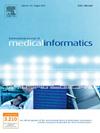从电子病历叙述中增强罕见病的深度表型检测:对Jeune综合征的评价
IF 4.1
2区 医学
Q2 COMPUTER SCIENCE, INFORMATION SYSTEMS
International Journal of Medical Informatics
Pub Date : 2025-06-21
DOI:10.1016/j.ijmedinf.2025.106021
引用次数: 0
摘要
背景:罕见病患者经常出现误诊和诊断延误。加快诊断对于确保及时获得适当护理至关重要。鉴于电子病历的可用性越来越高,将人工智能与大规模临床数据库的深度表型分析相结合,为识别未确诊患者提供了一种很有前途的方法。本研究评估了改进的表型提取对Jeune综合征筛查算法的影响,Jeune综合征是一种罕见的以骨骼异常为特征的纤毛病。方法分别依靠两个词库:标准的UMLS元词库和UMLS+(一个通过深度学习识别的附加术语的增强版本),从患者非结构化电子病历中自动提取Jeune综合征患者和对照组的表型。我们设计的用于肾纤毛病患者分类的机器学习管道适用于Jeune综合征的检测。该模型在使用两种表型策略创建的两个数据集上进行了训练和测试。结果使用UMLS+可明显改善Jeune综合征患者的分类,将敏感性从49%提高到95%,同时保持90%的特异性。对一组错误分类的对照组的回顾显示,他们中的大多数(69%)患有其他遗传性骨骼疾病,这表明该模型也捕获了将从转诊到骨病遗传学家那里受益的患者。结论基于人工智能的筛查结合高质量的深度表型分析有助于减少罕见病的诊断延误。电子病历表型的完整性和准确性对筛查性能有很大影响。本文章由计算机程序翻译,如有差异,请以英文原文为准。
Enhancing rare disease detection with deep phenotyping from EHR narratives: evaluation on Jeune syndrome
Background
Patients with rare diseases frequently experience misdiagnoses and long diagnostic delays. Accelerating their diagnosis is essential to ensure timely access to appropriate care. Given the increasing availability of EHRs, combining artificial intelligence and deep phenotyping from large-scale clinical databases offers a promising approach to identify undiagnosed patients. This study assesses the impact of improved phenotype extraction on a screening algorithm for Jeune syndrome, a rare ciliopathy characterized by skeletal abnormalities.
Methods
Phenotypes from Jeune syndrome patients and controls were automatically extracted from patient unstructured EHRs relying on two thesauri separately: the standard UMLS Metathesaurus and the UMLS+, an enhanced version incorporating additional terms identified through deep learning. The machine learning pipeline that we designed for classifying patients with renal ciliopathy was adapted for Jeune syndrome detection. The model was trained and tested on both the datasets created using the two phenotyping strategies.
Results
Using UMLS+ strongly improved the classification of patients with Jeune syndrome, increasing the sensitivity from 49 % to 95 % while maintaining a 90 % specificity. The review of a subset of misclassified controls showed that most of them (69 %) had other genetic skeletal disorders, indicating that the model also captured patients who would benefit from referral to a bone disease geneticist.
Conclusion
AI-based screening combined with high-quality deep phenotyping can help reduce diagnostic delay in rare diseases. The completeness and accuracy of phenotyping from EHRs have a strong impact on screening performances.
求助全文
通过发布文献求助,成功后即可免费获取论文全文。
去求助
来源期刊

International Journal of Medical Informatics
医学-计算机:信息系统
CiteScore
8.90
自引率
4.10%
发文量
217
审稿时长
42 days
期刊介绍:
International Journal of Medical Informatics provides an international medium for dissemination of original results and interpretative reviews concerning the field of medical informatics. The Journal emphasizes the evaluation of systems in healthcare settings.
The scope of journal covers:
Information systems, including national or international registration systems, hospital information systems, departmental and/or physician''s office systems, document handling systems, electronic medical record systems, standardization, systems integration etc.;
Computer-aided medical decision support systems using heuristic, algorithmic and/or statistical methods as exemplified in decision theory, protocol development, artificial intelligence, etc.
Educational computer based programs pertaining to medical informatics or medicine in general;
Organizational, economic, social, clinical impact, ethical and cost-benefit aspects of IT applications in health care.
 求助内容:
求助内容: 应助结果提醒方式:
应助结果提醒方式:


